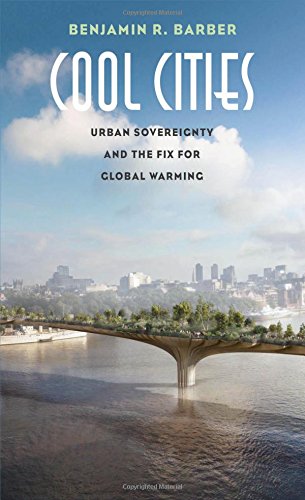Climate Change Conundrum
Can cities succeed when nations fail in the fight against global warming?
Cool Cities: Urban Sovereignty and the Fix for Global Warming. By Benjamin R. Barber. Yale University Press, New Haven, 2017. 224 pp.
When President Donald Trump announced he was withdrawing the United States from the Paris climate change agreement negotiated by his predecessor and adopted in 2015, international criticism was not slow in coming. China and India, major powers whom the Barack Obama administration had pressed into being more ambitious with their international commitments, joined a chorus of disappointed U.S. allies in Europe and Asia promising they would still, at the very least, honor the agreement and, in many cases, attempt to exceed their previously stated emissions reductions goals.
Aggrieved nation-states were not the only ones to articulate defiance in the face of U.S. retreat. American states and cities, many but by no means all governed by mayors belonging to Obama’s Democratic Party, made it quite clear that the Trump administration was not speaking for them. Not only did they see the strategic good sense in having the United States keep its word to the international community, they also saw the economic growth possibilities in becoming the pioneers of sustainable economic growth, to say nothing of the myriad positive health impacts for their citizens.
Such local action on climate change is not new. Ever since the establishment of an international climate regime at a summit in Rio de Janeiro in 1992, cities in particular have pioneered innovative solutions to address climate change and issues such as energy and pollution. That inclination has only grown as national governments have struggled to find consensus in international negotiations. As a result, the ability and willingness of states and municipalities to become policy entrepreneurs has been the subject of much study in the literature on global governance.
Add to that literature Cool Cities: Urban Sovereignty and the Fix for Global Warming by political theorist Benjamin R. Barber, best known for the 1995 Jihad vs. McWorld: Terrorism’s Challenge to Democracy on the struggle between tradition and globalization. In this latest work, Barber reports on how cities could be the vanguard of a new global politics. After the election of Donald Trump, he argues, it is time for cities, in the United States and worldwide, to increase the ambition of their goals, and to organize themselves transnationally in coalitions to share best practices, gauge the impact of their actions, and demonstrate to their superiors at the federal level they will act on the most critical issue facing mankind this century. Barber not only lays out why cities are important, but provides the legal and philosophical foundation for why they should act on climate change even when the federal governments to which they are titularly subordinate fail to act. His argument for the primacy of cities is convincing, as is his comprehensive overview of what coalitions currently exist to leverage urban ambition worldwide.
Cities have numerous advantages over their state and federal counterparts in pushing the envelope. Many cities are already endowed with the authority to make major investment decisions related to transportation infrastructure and housing. Barber cites two examples from Colombia where mayors have adopted transportation solutions like Bogatá’s rapid bus transit and Medellín’s cable car system, which are less carbon-intensive than the model of private automobile use that is ubiquitous in U.S. cities and less capital-intensive than building brand-new subway systems. Both are also environmentally sustainable and popular with the public. Barber rolls out numerous other examples: Seoul turning an eyesore highway into green space to improve air quality and increase the sense of community; Oslo investing heavily in building electric vehicle charging infrastructure; and New York City painting the roofs of buildings white to reflect, rather than trap, solar radiation.
Barber is less convincing on the politics and economics of action at the city level. In portraying cities as the guardians of a new climate politics, he assumes they possess a more democratic nature and, by extension, can move more nimbly to put into place the kind of policies that scientists, engineers, urban planners, and others have said are necessary to turn back global warming. But his contention that city governments are more democratically responsive than national or regional governments because they operate in closer proximity to citizens rests on a shaky foundation.
Despite the numerous admirable examples of what cities are doing, it does not automatically mean that they are always and everywhere able to translate their flexibility into better overall policies. The concept of NIMBY, an acronym for Not In My Backyard, does not make an appearance in Barber’s book, even though anyone in urban policy knows it is a reason why initiatives to advance the overall good often do not gain traction. For every example of the way cities can develop new initiatives and quickly implement them, there are counterexamples of how local politics can be just as polarized and gridlocked as national politics.
To take one example that has become more prominent during the Bill de Blasio administration, New York City has a significant and growing homelessness problem. One of the more efficient and humane strategies for addressing the issue would be to build more homeless shelters, spread throughout the city. Yet such new construction is a nonstarter in many neighborhoods because people do not want transient populations near where they live. Such resistance can be found in other policy areas such as energy. Nuclear power is the second-largest source of electricity generation in New York State, with the Indian Point Energy Center about thirty-five miles north of Manhattan directly supplying New York City. For years environmental activists have agitated for its closure as part of a larger antinuclear campaign. If the activists were successful, New York State’s reliance on fossil fuels (like natural gas, which is the number-one generating source) would increase. While that could be called a victory for democracy, it could be a defeat for efforts to stem climate change.
The economic obstacles to a new paradigm for cities are likely even more intractable. Cities are indeed the wealthiest entities in virtually every country worldwide. Yet their vast resource potential, even when combined with adjoining urban areas, still pales in comparison with nation-states. New York City’s $84.86 billion annual budget cannot stand in for a federal clean energy research and development program, electric vehicles, or agricultural resilience. The reason that nation-states are preferred climate leaders is because they have the ability to pool resources from a variety of economic actors within their jurisdictions to fund research and development, enact policies and regulations, and enforce an all-sectors approach to de-carbonization, while at the same time being able (at least theoretically) to redistribute the economic gains to less wealthy areas.
Cities are less a fix for global warming, as Barber would have it, than a mechanism for persuasion. This is a welcome and necessary contribution, but is not sufficient on its own to create the political space for true de-carbonization goals. Cities can certainly be leaders on climate change and energy policy, as Barber amply illustrates, but the focus must be less on making cities an exceptional set of actors separate from their national context, as Barber seems to advocate, and more as labs for convincing everyone about what is necessary to solve the climate crisis.
Neil Bhatiya is Research Associate for the Energy, Economics, and Security Program at the Center for a New American Security. On Twitter: @NeilBhatiya.





